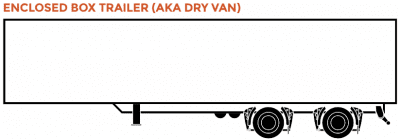What Are the Different Types of Truck Trailers?
Dry Van Trailer
Dry van trailers are closed box trailers without temperature control. The largest amount of the world’s cargo is moved by dry vans. These trailers are fully enclosed and protected, and they don’t have any temperature control. That’s why dry vans are used for moving commodities that are not temperature-sensitive: textile and clothing items, electronics, plastic, and building products, etc. They have doors on the back, so they can only be loaded from the rear. Usually, a dry van trailer is 53 feet in length, but in some cases, it can be 48 feet.
Dry Van Trailer Dimensions:
Capacity:

Refrigerated Trailer
Refrigerated trailers (also known as reefers) are trucks with temperature control. These types of truck trailers have a refrigeration unit that can be set to an exact temperature, freezing, or be turned off completely.
Refrigerated Trailer Dimensions:
Capacity:

Flatbed Trailer
The flatbed trailer is a type of open deck equipment with no sides and no roof, mainly used for transporting industrial commodities. The flatbed trailer is very versatile, making it a common asset for carriers. It is a basic form trailer, with no sides or roof, providing quick and easy loading and unloading.
Open deck equipment is the most flexible with loading/unloading. These trailers are commonly used. Usually, a flatbed trailer is 48 feet in length, but in some cases, it can be 53 feet.
Flatbed Trailer Dimensions:
Capacity:

Step Deck Trailer
Step deck trailer, or drop deck trailer, is an open type of trailer with two deck levels: an upper deck and a lower deck that drops down after clearing the tractor unit. Generally, step deck trailers can haul taller loads than flatbed trailers and often have ramps for unloading. They also tend to be safer for forklift pickups, due to the fact that they are closer to the ground. The main deck of a step-deck is lowered to adjust the center of gravity and allow the higher material to be hauled.
Step Deck Trailer Dimensions:
Capacity:

Double Drop Deck Trailer
Double Drop trailers are similar to step decks, but they have a lower gravity center. This allows us to load a shipment on a higher level and to be hauled 1 – 1.5 feet off the ground. Double Drop Deck is a longer piece of a trailer, called a “well”, in the middle that dips below trailer axles. The well ranges from 25 to 29 feet, making it ideal for taller, shorter freight. Double Drop Deck trailers usually have 2 or more axles, and a “Flip axle”, which can flip up and lay on the deck or flip-down and create extra axle for balancing weight. Double Drop trailers are used for oversized freight that is taller than 10 feet.
Double Drop Deck Trailer Dimensions:
Capacity:

Conestoga Trailer
Conestoga trailers are also known as a roll-tight or covered wagon. They have fixed fronts, but sides, top, and rear push forward like an accordion to expose a flat deck.
Conestoga Trailer Dimensions:
Capacity:


